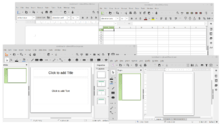Productivity software
Productivity software (also called personal productivity software or office productivity software[1]) is application software used for producing information (such as documents, presentations, worksheets, databases, charts, graphs, digital paintings, electronic music and digital video).[2] Its names arose from the fact that it increases productivity, especially of individual office workers, from typists to knowledge workers, although its scope is now wider than that. Office suites, which brought word processing, spreadsheet, and relational database programs to the desktop in the 1980s, are the core example of productivity software. They revolutionized the office with the magnitude of the productivity increase they brought as compared with the pre-1980s office environments of typewriters, paper filing, and handwritten lists and ledgers. Some 78% of "middle-skill" occupations (those that call for more than a high school diploma but less than a bachelor's degree) now require the use of productivity software.[3] In the 2010s, productivity software has become even more consumerized than it already was, as computing becomes ever more integrated into daily personal life.
Details
Productivity software traditionally runs directly on a computer. For example, Commodore Plus/4 model of computer contained in ROM for applications of productivity software. Productivity software is one of the reasons people use personal computers.
Productivity software can fall into the following categories:
Time Management Software: With time management software, one is able to track time on a desktop without any user intervention. This allows the person to analyse how much time is spent on each task and what one can do to re-prioritise his tasks and spend time on the most important tasks.
Project Management Software: With project management software, one is able to delegate, track major projects and have a quick overview of the progress made by each team member.
Office suite

An office suite is a collection of bundled productivity software (a software suite) intended to be used by knowledge workers. The components are generally distributed together, have a consistent user interface and usually can interact with each other, sometimes in ways that the operating system would not normally allow.[4]
The earliest office suite for personal computers was Starburst in the early 1980s, comprising the word processor WordStar, together with companion apps CalcStar (spreadsheet) and DataStar (database).[5] Various other suites arose in the 1980s, and over the course of the 1990s Microsoft Office came to dominate the market,[6] a position it retains as of 2018.
Typical office suite components
Existing office suites contain wide range of various components. Most typically, the base components include:
Other components of office suites include:
- Database software
- Graphics suite (raster graphics editor, vector graphics editor, image viewer)
- Desktop publishing software
- Formula editor
- Diagramming software
- Email client
- Communication software
- Personal information manager
- Notetaking software
- Groupware
- Project management software
- Web log analysis software
See also
- Integrated software
- List of office suites
- List of collaborative software
- List of personal information managers
- List of software that supports Office Open XML
- Comparison of word processors
- Comparison of spreadsheet software
- Comparison of notetaking software
- Online office suite
- Online spreadsheet
- OpenDocument software
References
- ↑ "office productivity software". PC Magazine Encyclopedia. Ziff Davis. Retrieved 30 November 2014.
- ↑ "productivity software". PC Magazine Encyclopedia. Ziff Davis. Retrieved 30 November 2014.
- ↑ Crunched by the Numbers: The Digital Skills Gap in the Workforce, Burning Glass Technologies, March 2015
- ↑ "office suite". PC Magazine Encyclopedia. Ziff Davis. Retrieved 30 November 2014.
- ↑ John C. Dvorak. "Whatever Happened to Wordstar?". Retrieved 2015-08-22.
- ↑ A Brief History of Computing, by Gerard O'Regan, p. 87
External links
- Office Suites at Curlie (based on DMOZ)
- "Review: Open-Source Office Suites Compared". InformationWeek. United Business Media. 8 December 2008.
